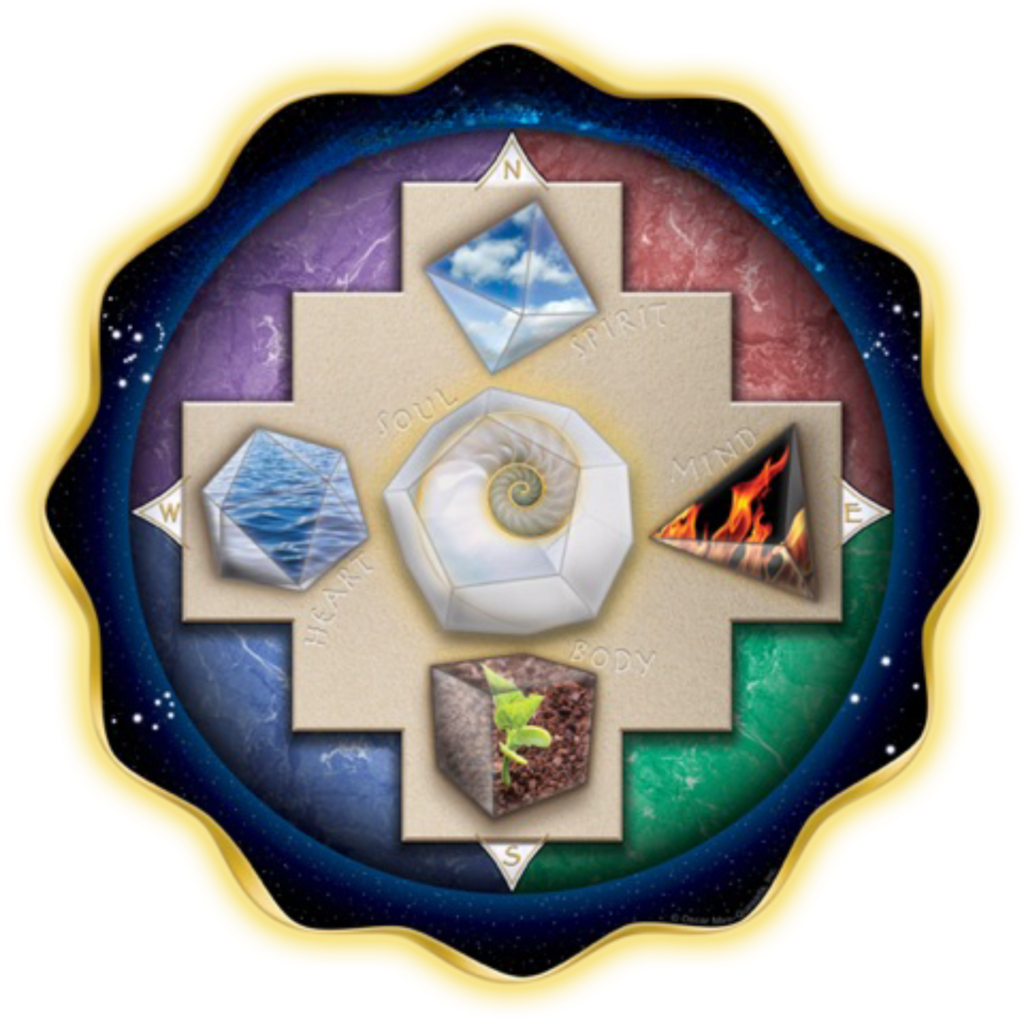Cosmovision refers to a worldview that encompasses an understanding of the universe, humanities place in it, and our relationship with the natural world and the cosmos. It goes beyond mere intellectual understanding and shapes one’s perception, values, and behaviors.
Cosmovisions vary across different cultures and traditions, reflecting their unique perspectives and experiences. Indigenous cultures, in particular, often have distinct and profound cosmovisions that have been passed down through generations. This cosmovision has been adapted from the Pachakuti Mesa Tradition and transmits wisdom from of Andean cosmology, earth-honouring ceremonies, and healing arts.
At its core, a cosmovision seeks to answer fundamental questions about existence, meaning, and interconnectedness. It encompasses beliefs about the nature of reality, the origins of the universe, the interplay of spiritual and material realms, the role of humanity, and the relationships between humans, nature, and the divine.
In many cosmovisions, there is a recognition of the inherent sacredness of all life forms and the interconnectedness of everything. There is often a deep reverence for the natural world, with the belief that humans are an integral part of a larger cosmic web. Harmony, balance, and reciprocity are often emphasized, as well as the responsibility to live in harmony with nature and to be caretakers of the Earth.

Cosmovisions can encompass cosmological narratives, creation stories, myths, rituals, and ceremonies that help individuals and communities understand and connect with the larger cosmic order. They provide a framework for understanding the human experience, guiding ethical and moral behavior, and offering insights into the purpose and meaning of life.
Exploring and honoring cosmovisions can foster a greater appreciation for the richness and depth of human wisdom, deepening our understanding of different cultural perspectives and promoting a more holistic and interconnected worldview.
Cosmovisions as a Living Archetype
A cosmovision can be understood as a living archetype in the sense that it represents an embodiment of archetypal patterns and principles that shape the worldview and collective consciousness of a particular culture or community. Archetypes, as described by Carl Jung, are universal, symbolic patterns or themes that are present in the collective unconscious of humanity.
In the context of a cosmovision, it serves as a living archetype by encompassing and expressing the foundational beliefs, values, and myths that guide a community’s understanding of the world and their place in it. It is an organizing framework that influences the perception, behavior, and identity of individuals within some cultures.
Similar to how archetypes operate, a cosmovision carries deep symbolic meaning and serves as a blueprint for understanding and engaging with the cosmos, nature, and the human experience. It represents the fundamental patterns of existence, the interplay between different realms (physical, spiritual, and mythological), and the relationships between individuals, society, and the natural world.
As a living archetype, a cosmovision continues to evolve and adapt to changing circumstances while retaining its core principles and symbols. It is woven into the rituals, traditions, stories, and ceremonies of a culture, providing a sense of continuity, identity, and purpose. It shapes the way individuals perceive and relate to themselves, others, and the wider cosmos.
By engaging with a cosmovision as a living archetype, individuals and communities can tap into the collective wisdom, symbolism, and transformative potential embedded within it. It offers a framework for personal growth, spiritual exploration, and a deeper connection with the mysteries of existence.
It’s important to note that different cultures and communities have their own unique cosmovisions, each representing a distinct living archetype that reflects their particular history, geography, and spiritual traditions. Exploring and honoring these diverse cosmovisions can enrich our understanding of the human experience and foster a greater appreciation for the multiplicity of ways in which we relate to and make meaning of the world.
The Sacred Center
The sacred center, within the context of a cosmovision, represents a symbolic and spiritual focal point that holds deep significance and acts as a nexus of connection between different realms, dimensions, and aspects of existence. It is a concept found in various indigenous, spiritual, and mystical traditions worldwide.
The sacred center is often considered the axis mundi, the axis or center of the world, around which the cosmos and all of creation revolve. It is a point of convergence and intersection, bridging the physical and spiritual realms, and serving as a link between the mundane and the divine.
In many cosmovisions, the sacred center may manifest in different forms, such as a sacred site, a temple, a natural landmark, or a symbolic representation. Examples include mountains, pyramids, caves, rivers, or specific geographic locations deemed sacred by a particular culture.
The sacred center represents a place of power, often associated with creation, balance, harmony, and spiritual energy. It is believed to be a source of wisdom, healing, and connection with higher realms or divine forces. Rituals, ceremonies, and pilgrimages are often conducted at the sacred center to honor and connect with the spiritual essence and significance it holds.
Beyond its physical manifestations, the sacred center can also be understood as an inner state of consciousness or a metaphorical center within oneself. It represents a deep spiritual core where one can access higher knowledge, inner peace, and a sense of alignment with the greater cosmos.
The significance of the sacred center lies in its ability to provide a point of reference and orientation, reminding individuals and communities of their interconnectedness with the divine, the natural world, and each other. It serves as a reminder of the sacredness inherent in all aspects of life and the potential for transformation and transcendence.
By acknowledging and honoring the sacred center within a cosmovision, individuals and communities cultivate a deeper sense of reverence, connection, and purpose, aligning themselves with the larger cosmic order and the spiritual dimensions of existence.



